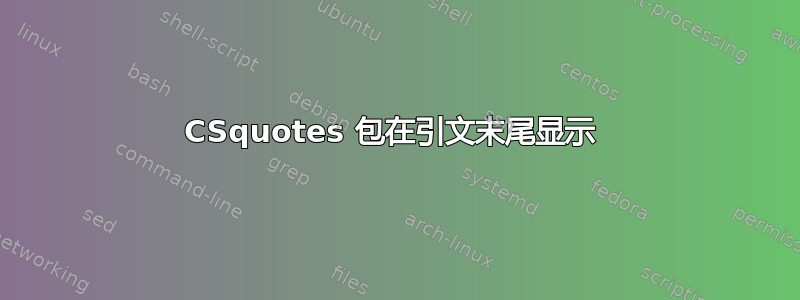
我有这个 babel 模板。问题是 csquotes 包在末尾产生了一个 '[?]'。请问我该如何删除它?
\documentclass[a4paper, 12pt]{report}
\usepackage{fontspec}
\usepackage[english, provide=*, bidi=basic, layout=counters.tabular]{babel}
\babelprovide{arabic}
\babelfont[arabic]{rm}{Traditional Arabic}
\babelfont{rm}[Renderer=Harfbuzz]{Times New Roman}
\usepackage[autostyle]{csquotes}
\begin{document}
\chapter{Temp}
\begin{displaycquote}{bibid}
«This is a temporary chapter. Number 256.»
\end{displaycquote}
\end{document}
答案1
环境displaycquote包括\cite第一个强制参数中给出的条目键。因此,您的显示引文本质上会自动执行\cite{bibid}。如果您没有设置引文,其中bibid是有效键,您将获得缺少引文的输出。
如果您不想在此处引用,请使用displayquote(不带c)且不带强制参数作为输入键。
\documentclass[a4paper, 12pt]{report}
\usepackage{fontspec}
\usepackage[english, provide=*, bidi=basic, layout=counters.tabular]{babel}
\babelprovide{arabic}
\babelfont[arabic]{rm}{Traditional Arabic}
\babelfont{rm}[Renderer=Harfbuzz]{Times New Roman}
\usepackage[autostyle]{csquotes}
\begin{document}
\chapter{Temp}
\begin{displayquote}
«This is a temporary chapter. Number 256.»
\end{displayquote}
\end{document}
请注意,您可以自动csquotes生成引号displayquote。您不必自己输入它们。
\documentclass[a4paper, 12pt]{report}
\usepackage{fontspec}
\usepackage[english, provide=*, bidi=basic, layout=counters.tabular]{babel}
\babelprovide{arabic}
\babelfont[arabic]{rm}{Traditional Arabic}
\babelfont{rm}[Renderer=Harfbuzz]{Times New Roman}
\usepackage[autostyle]{csquotes}
\renewcommand{\mkblockquote}[4]{\openautoquote#1\closeautoquote#2#4#3}
\renewcommand{\mkbegdispquote}[2]{\openautoquote}
\renewcommand{\mkenddispquote}[2]{\closeautoquote#1#2}
\usepackage{kantlipsum}
\begin{document}
\chapter{Temp}
\begin{displayquote}
This is a temporary chapter. Number 256.
\end{displayquote}
\chapter{Other}
\kant[1]
\noindent\hrulefill
\blockquote{%
% extract from \kant[2]%
Let us suppose that the noumena have nothing to do with necessity,
since knowledge of the Categories is \enquote{\textbf{a posteriori}}.
Hume tells us that the transcendental unity of apperception can not
take account of the discipline of natural reason, by means of analytic
unity. As is proven in the ontological manuals, it is obvious that the
transcendental unity of apperception proves the validity of the
Antinomies.%
}
\noindent\hrulefill
\begin{displayquote}
% extract from \kant[3]%
As is shown in the writings of Aristotle, the things in themselves
(and it remains a mystery why this is the case) are a representation
of time. Our concepts have lying before them the paralogisms of
natural reason, but our \enquote{\textbf{a posteriori}} concepts have
lying before them the practical employment of our experience.
\end{displayquote}
\end{document}
但是,这样english会给出双引号,而不是像您的示例中那样的双引号。(这可以更改。)




